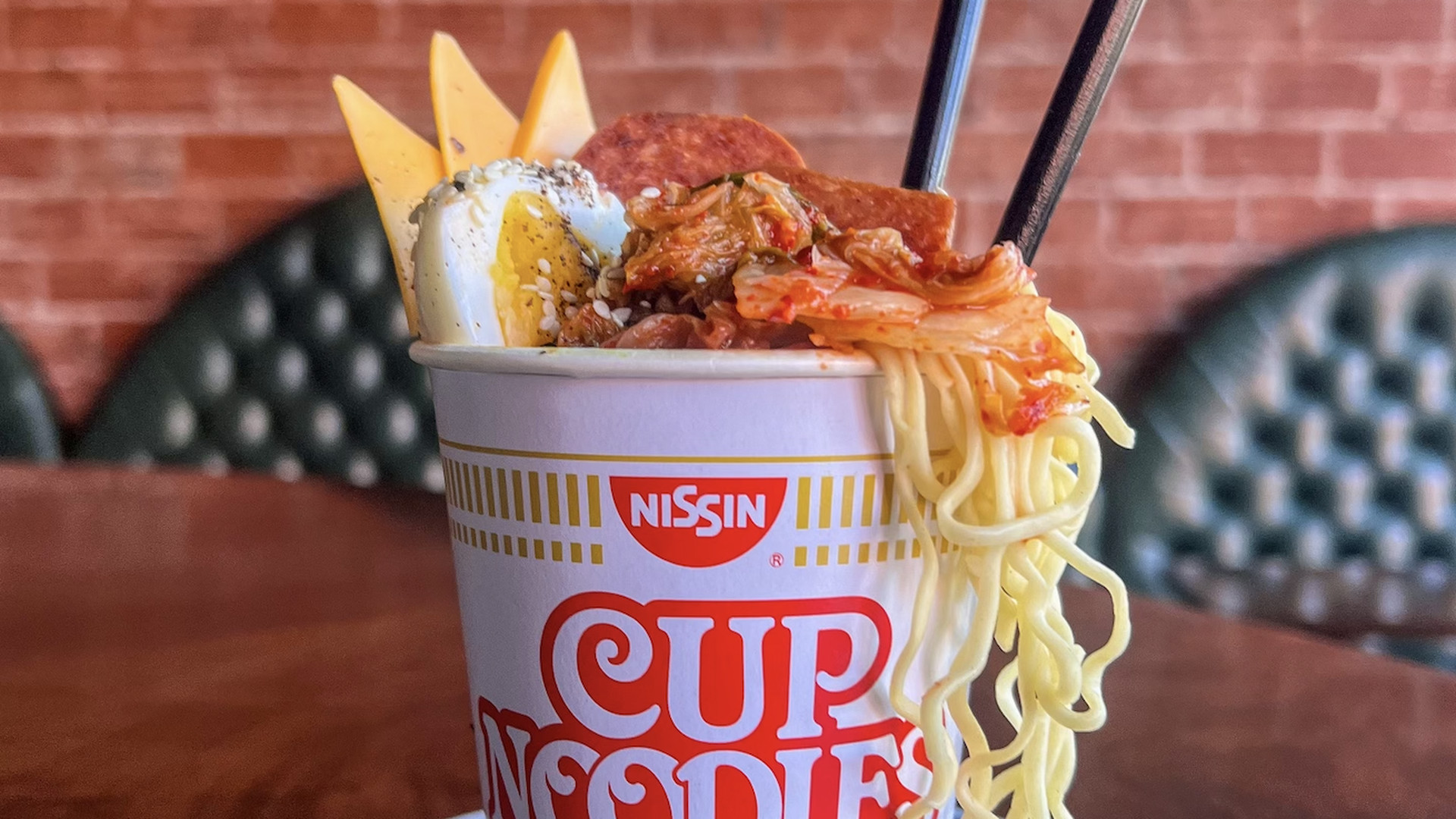
THE PORTLAND CULT OF CUP NOODLES
When visiting the tucked-away Statera Cellars tasting room in Southeast Portland, the smell of the space isn’t restricted to just wine. Sure, visitors may pick up on the bright acidity or effervescent fizz of Oregon white varietals and pet-nat, but they’ll also smell kimchi, maybe crab, and the salty, almost yeasty note of steam emerging from a disposable cup of instant noodles.
Below the wines by the glass and five-wine flight, a “Market Price Cup of Noodles” appears on Statera’s menu — the noodles come with a rotating cast of add-ons, which have included spicy Vietnamese prawns, cuttlefish, and sesame oil on past visits. The instant noodles themselves are not necessarily Cup Noodles branded, but the image is evocative of the styrofoam (now paper) cup of college dorm rooms and high school cafeteria halls.
“There’s something so universal about Cup Noodles for aging millennials and Gen Z kids,” co-owner Luke Wylde says. “We all know that experience of boiling water and making ourselves a snack.”
These upgraded instant noodles have appeared on Portland menus across the city. Thomas and Mariah Pisha-Duffly opened Southeast Clinton bar the Houston Blacklight with a French onion soup ramen, made with instant noodles. Yaowarat chef Sam Smith designed a menu of tricked-out instant ramen for The End, the cocktail bar from Hey Love owner Emily Mistell. New Northeast Portland spot Bistro Elysium uses Thai instant noodles in its version of pad kee mow, which it calls “Drunk Street Noodles.” And birria carts scattered across Portland filled branded paper instant noodle cups with consomé and beef for “ramen birria.” The trend plays into Portland’s longstanding fixation on the high-brow/low-brow dynamic, while also nodding to the city’s inherent scrappiness.
Japanese Taiwanese businessman Momofuku Ando invented instant ramen in 1958, flash-frying noodles so they could boil in water rapidly. On a trip to the United States, Ando noticed supermarket managers breaking up their instant noodles and putting them in a coffee mug with hot water, unable to prepare the noodles at an actual stovetop during a short break. He invented Cup Noodles in 1971, providing diners with a single vessel for both cooking and eating his noodles.
Some businesses, including Statera, like to serve Cup Noodles because of their ease of preparation: They don’t require an extensive kitchen, food costs, or dedicated staff for dishwashing or prep. “The noodles are served in the dish it comes in,” Wylde says. “I don’t want food loss to be a part of my cost of goods. ... This is a great way to make sure everything is shelf stable and doesn’t go bad.”
Cocktail bar Maeve keeps Cup Noodles on-hand “because the [Oregon Liquor and Cannabis Commission] says so,” in the words of the menu. Oregon, unlike many states around the country, requires cocktail bars with full liquor licenses to serve “at least five different meals available at all times;” these requirements are part of the reason why Portland is home to so many bars with strong culinary programs, but also why so many dive bars are stocked with Hungry-Man meals in their freezers.
Smith, who worked as a chef consultant for restaurants like Wild Thing and Sweedeedee, designed his menu for The End using similar parameters: Mistell was looking for menu items the team could serve without a full-on kitchen or kitchen staff. His idea came from a low-stakes pop-up he started in the fall of 2022, based off the Cup Noodles Museum in Japan: Within the Yokohama museum, visitors can design their own instant noodle cup, with a choice of fillings. So Smith started hosting Club Cup parties in his garage, where visitors would pick from an assortment of cool additions — spicy bamboo shoots, six-minute eggs — and create their own Cup Noodles.
For the bar, Smith stuck to Cup Noodles with specific combinations of add-ins. For example, one was inspired by the Mexican street corn esquites, with crema, hot sauce, and Tajín. Another took its cues from budae jjigae, with kimchi, American cheese, and Spam.
“It’s cool because of its convenience, but it also has this element of creativity to it,” Smith says. “People have this association with instant noodles being really low-brow, being something that doesn’t have a lot of substance. So you can take something like an instant noodle but maybe throw some higher quality things in there, something that’s really aesthetically pleasing.”
Birrieria PDX, the Glisan restaurant and fleet of food carts throughout the Portland area serving birria in a multitude of preparations, pours its chile-laden beef birria consomé over Tapatío instant noodles, sans seasoning packet. Owner Daniel Miranda first encountered the birria ramen trend in Los Angeles, but he says Birrieria PDX was the first to serve it locally. He’s partial to putting the noodles, saturated in the beefy base, inside his quesabirria to double-down on carbs. “The consomé is what keeps all the flavor,” he says. “If the consomé is good, and the birria is good, then the ramen is going to be absolutely amazing.”
Throughout his time at noodle company Nissin, Ando was known for his zen approach to the noodle business, sprinkling his own quotes throughout the employee handbook: “The fundamental misunderstanding of humanity is believing that we can achieve all our desires without limitation.” The appeal, then, of instant noodles seems to align with their origin story: an opportunity for creativity born out of constraints.
2024-03-28T17:05:40Z dg43tfdfdgfd